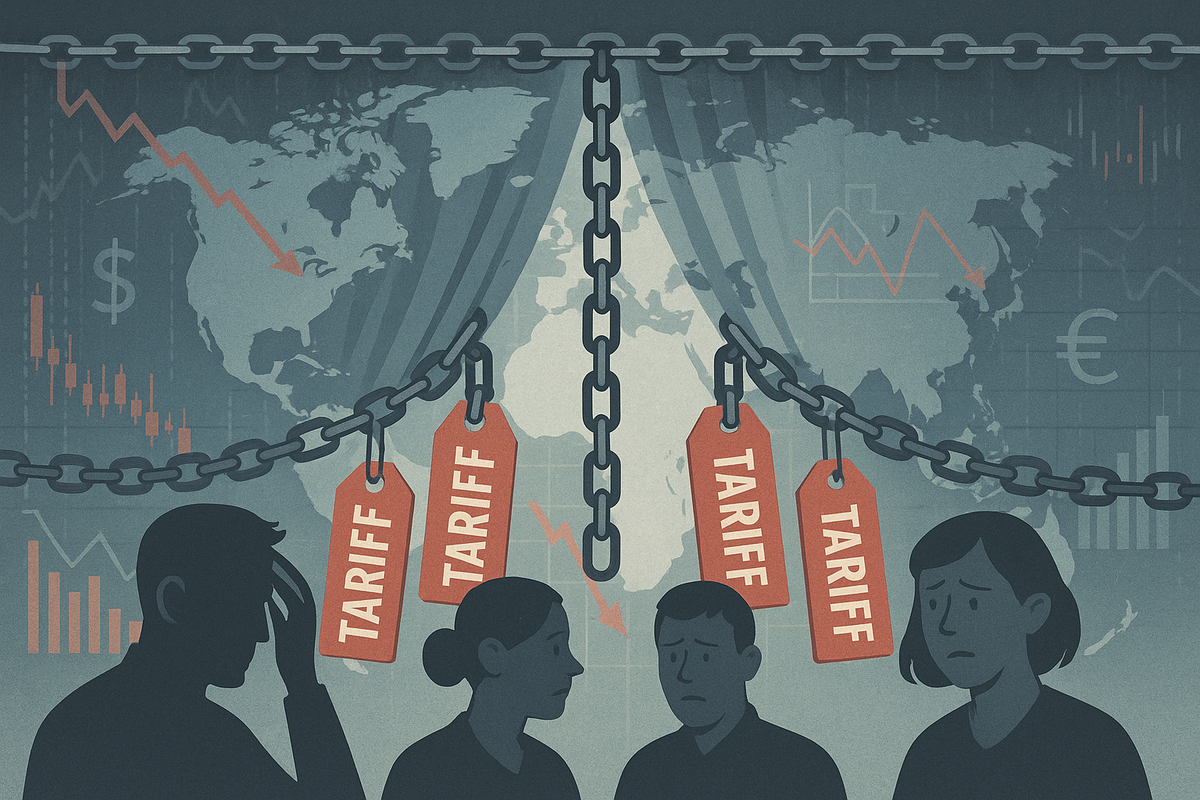
The global economic landscape is currently undergoing a seismic shift, as the United States has aggressively implemented a series of new tariffs and trade policy changes throughout 2025. These actions have dramatically increased the average effective U.S. tariff rate to levels not seen in decades, triggering immediate and far-reaching implications for both the U.S. and global economies. From inflationary pressures and economic slowdowns to reconfigured supply chains and heightened market volatility, the world is grappling with the profound consequences of this protectionist pivot.
This new era of trade policy, characterized by a focus on domestic production and national security, is challenging decades of free-trade orthodoxy. Businesses and consumers alike are feeling the pinch of rising costs, while international trade relations are strained, leading to a complex web of retaliatory measures and a re-evaluation of global economic partnerships. The long-term ramifications of these policies are still unfolding, but the immediate impact suggests a more fragmented and uncertain future for international commerce.
A New Era of Protectionism: What Happened and Why It Matters
The United States has embarked on an unprecedented campaign of tariff implementation and trade policy shifts throughout 2025, fundamentally altering the dynamics of global commerce. This aggressive stance, largely driven by a renewed focus on economic nationalism and national security, has seen the average effective U.S. tariff rate surge from approximately 2.5% at the beginning of the year to an estimated 18.6% by August 2025 – a level not witnessed since the 1930s.
The timeline of these actions reveals a rapid escalation. Under the Biden administration, strategic tariff modifications were introduced in May 2024, targeting Chinese goods in key sectors like electric vehicles (EVs), solar cells, and semiconductors, with tariffs on some items reaching 100%. Upon the second Trump administration taking office in January 2025, the pace accelerated dramatically. February 1, 2025, saw the imposition of "fentanyl" tariffs under the International Emergency Economic Powers Act (IEEPA), with 25% tariffs on imports from Canada and Mexico, and 10% on imports from China. These were followed by a universal 10% "reciprocal tariff" on nearly all U.S. imports on April 5, 2025, and a significant increase in Section 232 tariffs on steel and aluminum to 50% by June 4, 2025. Tariffs were also expanded to include automobiles and parts, copper, and a wide array of household appliances. Notably, the de minimis exemption for low-value imports is set to be eliminated on August 29, 2025, meaning even small shipments will be subject to duties.
Key players in this policy shift include the President of the United States, who has directly announced and directed these policies, and the Office of the United States Trade Representative (USTR), responsible for their implementation and enforcement. The Department of Commerce has also played a role in expanding tariffs. While federal courts have ruled some IEEPA tariffs illegal, they remain in effect pending appeal, highlighting the legal complexities surrounding these actions.
Initial market reactions have been swift and often volatile. President Trump's "Liberation Day" tariffs on April 2, 2025, triggered a sharp global market slump, with the U.S. stock market erasing $6.6 trillion in value in just two days. The S&P 500, Dow Jones Industrial Average, and Nasdaq-100 all experienced significant drops. Investors flocked to safe-haven assets like the Japanese yen, Swiss franc, and gold, while bond markets saw increased demand. However, a temporary pause in some planned tariffs on April 9, 2025, led to a sharp reversal of these losses, demonstrating the market's sensitivity to trade policy shifts. Despite some de-escalation through negotiations, the overall economic outlook remains cautious, with Fitch Ratings projecting a slowdown in global economic growth to 2.2% in both 2025 and 2026, largely due to the U.S. tariff shock.
Navigating the New Trade Winds: Winners and Losers Emerge
The sweeping U.S. tariff actions and trade policy shifts have created a distinct divide between potential winners and losers across various industries and companies, fundamentally altering competitive landscapes and supply chain strategies.
On the winning side, domestic manufacturing and industrial sectors with strong U.S.-based production facilities are poised to gain. Companies like Nucor (NUE), Cleveland-Cliffs (CLF), and U.S. Steel (X), major domestic steel producers, are benefiting from reduced foreign competition and higher domestic prices due to increased tariffs on imported steel and aluminum. Similarly, U.S. automakers with significant domestic production, such as General Motors (GM), Ford (F), and Tesla (TSLA), could see an advantage from tariffs on imported vehicles and parts, making their domestically assembled cars more competitive. The energy sector also stands to benefit, with U.S. producers like ExxonMobil (XOM), Chevron (CVX), and Cheniere Energy (LNG) potentially gaining market share if tariffs are imposed on imported energy sources. The defense and aerospace industry, including companies like Lockheed Martin (LMT) and Raytheon Technologies (RTX), could see increased contract opportunities as the U.S. government prioritizes domestic production in defense procurement.
Conversely, a broad spectrum of industries and companies heavily reliant on global supply chains and imports are facing significant headwinds. Import-heavy retailers, such as Walmart (WMT) and Target (TGT), are grappling with increased costs for consumer goods, electronics, and textiles, particularly those sourced from China. These higher costs are often passed on to consumers, potentially dampening demand. Small importers are particularly vulnerable, lacking the resources to quickly adapt to rising tariff costs or reconfigure supply chains. The agricultural sector has been hit hard by retaliatory tariffs from countries like China, Mexico, and Canada, leading to reduced exports of U.S. products like soybeans, dairy, and pork. This impacts farmers and agricultural companies, such as Archer-Daniels-Midland (ADM) and Bunge Global SA (BG).
Companies with integrated global supply chains, especially in the automotive and technology sectors, are experiencing higher production costs and disruptions. Tariffs on steel and aluminum, for instance, increase the cost of manufacturing for carmakers, while duties on electronic components affect tech giants like Apple (AAPL) and Samsung (005930.KS). The mining sector, heavily dependent on foreign inputs, faces increased costs for commodities like rare earths and certain metals. The construction industry is also feeling the pinch, with higher prices for materials like steel and aluminum impacting infrastructure projects and housing costs. Even the healthcare and pharmaceutical sectors could face challenges, as a significant portion of active pharmaceutical ingredients are manufactured abroad, with the threat of very high tariffs potentially leading to margin compression for companies like Pfizer (PFE) and Merck (MRK). The elimination of the de minimis exemption will further impact small businesses and consumers by subjecting even low-value imports to tariffs.
A Global Reordering: Industry Impact and Broader Implications
The U.S. tariff actions and trade policy shifts are not merely isolated incidents; they represent a fundamental reordering of global economic relationships, with profound implications for industries, supply chains, and international cooperation. This protectionist wave is challenging the very foundations of the globalized economy that has evolved over decades.
One of the most significant broader industry trends is the fragmentation and restructuring of global supply chains. Companies across sectors, from technology to apparel, are being forced to re-evaluate their sourcing strategies, seeking to diversify away from heavily tariffed regions like China and explore alternative production hubs in countries like India and Vietnam. This shift, while aiming to enhance resilience and reduce reliance on single points of failure, can also lead to increased costs, logistical complexities, and potential bottlenecks as new supply networks are established. For instance, Apple (AAPL) is actively accelerating efforts to move manufacturing out of China, a move that has ripple effects throughout its vast supplier ecosystem.
The ripple effects extend to retaliatory tariffs from affected trading partners. Countries like China, Mexico, and the European Union have already implemented or are threatening their own tariffs on U.S. exports, creating a "tit-for-tat" trade war. This directly harms American agricultural producers and manufacturers who rely on foreign markets, leading to reduced sales and increased market uncertainty. The agriculture industry, in particular, is highly vulnerable, as U.S. farmers face both higher input costs and diminished export opportunities.
From a regulatory standpoint, the extensive use of executive authority, such as the International Emergency Economic Powers Act (IEEPA), to implement tariffs raises concerns about the circumvention of traditional legislative processes. This approach can lead to increased uncertainty and volatility in trade relations, making it difficult for businesses to plan long-term. Furthermore, the U.S. stance on Digital Services Taxes (DSTs) has escalated tensions with global partners, leading to retaliatory tariff threats and forcing tech firms to rethink their global operations. The current policy also marks a significant departure from the U.S.'s historical role in promoting multilateral free trade agreements, potentially undermining institutions like the World Trade Organization (WTO).
Historically, the current situation draws parallels to the Smoot-Hawley Tariff Act of 1930, which is widely considered to have exacerbated the Great Depression by triggering widespread retaliatory tariffs and a dramatic collapse in global trade. While the economic context is different today, the lessons from that period – of tariffs leading to reduced trade, higher unemployment, and economic contraction – serve as a cautionary tale. The U.S. had largely moved away from such protectionist policies after World War II, embracing trade liberalization through agreements like GATT and the WTO. The current shift represents a significant reversal of this trend, signaling a return to tariffs as a primary tool of economic policy. This could lead to a more protectionist global environment, with countries increasingly prioritizing domestic industries over international cooperation, potentially hindering global economic growth and fostering greater geopolitical friction.
The Road Ahead: What Comes Next
The path forward for U.S. tariffs and trade policy points towards a continued, and likely entrenched, era of economic nationalism. In the short term, businesses and consumers should brace for sustained inflationary pressures as the costs of tariffs are passed through the supply chain. The average U.S. tariff rate, already significantly elevated, is projected to remain high, potentially approaching 20%. This will translate into higher prices for a wide array of goods, from metals and crops to clothing and automobiles, impacting household purchasing power and potentially contributing to a slowdown in economic growth. Global trade volumes are also expected to continue their decline as countries adjust to the new trade landscape.
In the long term, tariffs are likely to become a permanent fixture of U.S. trade policy, partly due to the revenue they generate for the federal budget. This permanence will necessitate significant strategic pivots for businesses worldwide. Companies will continue to reconfigure their global supply chains, prioritizing resilience and diversification over pure cost efficiency. This will involve increased nearshoring and reshoring of production, particularly in critical sectors, to reduce reliance on foreign imports and mitigate tariff risks. The focus will shift towards building more robust and geographically diverse supply networks, even if it means higher production costs.
These shifts will also create new market opportunities. The emphasis on domestic manufacturing is already catalyzing a revival in certain sectors, such as furniture, where tax incentives are spurring growth. This presents opportunities for companies that can scale domestic production and leverage these incentives. Investors will increasingly look to hedge against short-term inflation while targeting sectors poised for growth in this reshaped trade environment, including domestic manufacturing and potentially certain emerging markets that become alternative sourcing hubs. However, the potential for retaliatory tariffs from trading partners remains a significant challenge, which could further complicate export markets for U.S. companies and escalate into broader trade conflicts.
Several potential scenarios for the future of U.S. customs policy have been outlined. A "base scenario" suggests that most current tariffs will be maintained, with new sectoral tariffs introduced, leading to an average tariff rate of around 15.5%. This could result in a significant decrease in U.S. imports, substantial tariff revenues, a notable drop in U.S. GDP, and an increase in prices. A "high tariff scenario," representing a worst-case outcome, could see the average tariff rate reach 28%, with even more drastic reductions in imports, a larger hit to GDP, and a greater risk of stagflation. Conversely, a "low tariff scenario" would involve a partial reduction in tariff rates. The ongoing legal challenges to tariffs imposed under the IEEPA could also significantly alter the effective tariff rate if they are ultimately deemed unlawful. Investors should closely monitor these legal developments, as well as the progress of trade negotiations and any new tariff announcements or retaliatory measures, as these will be key drivers of market volatility and economic performance in the coming months and years.
A New Global Economic Order: Conclusion
The current wave of U.S. tariffs and trade policy shifts represents a watershed moment in global economic history, marking a decisive departure from the multilateral free-trade principles that have largely governed international commerce for decades. The immediate impact has been a surge in the average effective U.S. tariff rate to levels not seen since the Great Depression, triggering widespread inflationary pressures, a projected slowdown in economic growth, and significant market volatility. This aggressive protectionist stance, driven by a desire to bolster domestic industries and address perceived trade imbalances, has fundamentally altered the landscape for businesses and consumers alike.
The key takeaway is that tariffs are not merely a tax on foreign goods; they are a tax on domestic consumers and businesses, leading to higher prices, reduced purchasing power, and ultimately, a less efficient economy. While the stated goals of these policies often include bringing manufacturing back to the U.S. and increasing tax revenue, the economic burden is largely borne by American households and companies. The market has reacted with sharp sell-offs and heightened uncertainty, reflecting concerns about the impact on corporate earnings, profit margins, and overall economic stability. Multinational corporations with complex global supply chains, as well as import-heavy retailers and the agricultural sector, are particularly vulnerable to these shifts.
Looking ahead, the lasting impact of these policies points towards a more regionalized and resilient, albeit potentially less efficient, global economy. The era of seamless globalization, driven primarily by economic efficiency, is giving way to a landscape where geopolitical considerations, national security, and supply chain resilience take precedence. This will necessitate a fundamental restructuring of global supply chains, with companies increasingly seeking to diversify sourcing, nearshore, or reshore production. The U.S. economy is projected to be persistently smaller in the long run, with declining wages and rising unemployment, while consumer prices are expected to remain elevated across various sectors. Globally, countries heavily reliant on exports to the U.S. face significant vulnerabilities, and the potential for retaliatory measures could further fragment global trade.
Investors navigating this uncertain environment should remain vigilant. Key indicators to watch include the progress of trade negotiations, any new tariff announcements or retaliatory measures, and crucial inflation and growth data, which will influence the Federal Reserve's monetary policy decisions. Companies demonstrating agility in adapting their supply chains, diversifying market access, and innovating to reduce dependencies will be better positioned for success. While tariffs present significant challenges, the resulting market dislocations can also create opportunities for active management and diversified portfolios. The coming months will be critical in determining the full extent of this new global economic order and its lasting impact on markets, industries, and international relations.





